 Miscellaneous
Miscellaneous  Miscellaneous
Miscellaneous  Politics
Politics 10 Lesser-Known Far-Right Groups of the 21st Century
 History
History Ten Revealing Facts about Daily Domestic Life in the Old West
 Weird Stuff
Weird Stuff 10 Everyday Products Surprisingly Made by Inmates
 Movies and TV
Movies and TV 10 Actors Dragged out of Retirement for One Key Role
 Creepy
Creepy 10 Lesser-Known Shapeshifter Legends from Around the World
 Animals
Animals 10 Amazing Animal Tales from the Ancient World
 Gaming
Gaming 10 Game Characters Everyone Hated Playing
 Books
Books 10 Famous Writers Who Were Hypocritical
 Humans
Humans 10 of the World’s Toughest Puzzles Solved in Record Time
 Miscellaneous
Miscellaneous 10 Ironic News Stories Straight out of an Alanis Morissette Song
 Politics
Politics 10 Lesser-Known Far-Right Groups of the 21st Century
 History
History Ten Revealing Facts about Daily Domestic Life in the Old West
Who's Behind Listverse?

Jamie Frater
Head Editor
Jamie founded Listverse due to an insatiable desire to share fascinating, obscure, and bizarre facts. He has been a guest speaker on numerous national radio and television stations and is a five time published author.
More About Us Weird Stuff
Weird Stuff 10 Everyday Products Surprisingly Made by Inmates
 Movies and TV
Movies and TV 10 Actors Dragged out of Retirement for One Key Role
 Creepy
Creepy 10 Lesser-Known Shapeshifter Legends from Around the World
 Animals
Animals 10 Amazing Animal Tales from the Ancient World
 Gaming
Gaming 10 Game Characters Everyone Hated Playing
 Books
Books 10 Famous Writers Who Were Hypocritical
 Humans
Humans 10 of the World’s Toughest Puzzles Solved in Record Time
Mysterious Discoveries That Could Completely Rewrite History
Most of history comes from what gets written down. But what we know of our past is only a sliver of everything that happened. A great deal of where we came from was never etched into a stone and, today, has been lost.
We don’t know what’s missing from the patchwork of history. But every now and then, archaeologists find things that don’t quite fit with what’s been written down. We find relics from a society left in a place that should have been a world away from its owners.
Nobody knows for sure how these things got there, but they suggest some incredible events that might never have been recorded. Some of the greatest adventures may have happened to people who never made it home to tell the tale—and they might completely change the history of our world.
10 A Roman Sword In Canada
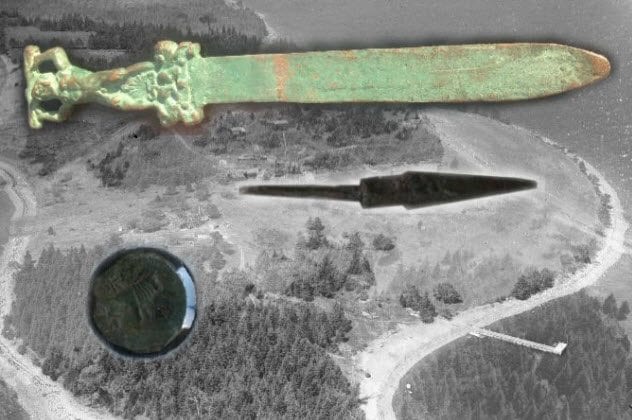
On Oak Island, Nova Scotia, a TV crew accidentally stumbled upon the last thing they ever expected to find: an ancient Roman sword that seems to have been there since AD 200.
The sword alone is shocking—it suggests that a Roman might have made it to North America 800 years before the Vikings. But it’s not even the only thing they found. Other people have stumbled upon other strange things that shouldn’t be in Canada: a crossbow bolt wedged into a tree, a Roman-style burial mound, Carthaginian coins, and even a stone with what appears to be Roman writing on it—all made about 1,800 years ago.
It’s theorized that a group of Roman and Carthaginian explorers might have traveled out West about 1,800 years ago. They may never have made it home and may have buried their dead on the island—explaining why there are Roman graves in Canada and no record of their trip in Rome.
None of this has been proven yet—and the fact that the sword was found by a TV crew instead of archaeologists makes it easy to be a little suspicious. Still, it’s a lot of evidence. If expert testing backs it up, it could change the history of the first Europeans to visit the Americas.
NOTE: According to this source (thanks Fuzzybunny), the sword is a fake.
9 Chinese Oracle Bone Writing In The United States
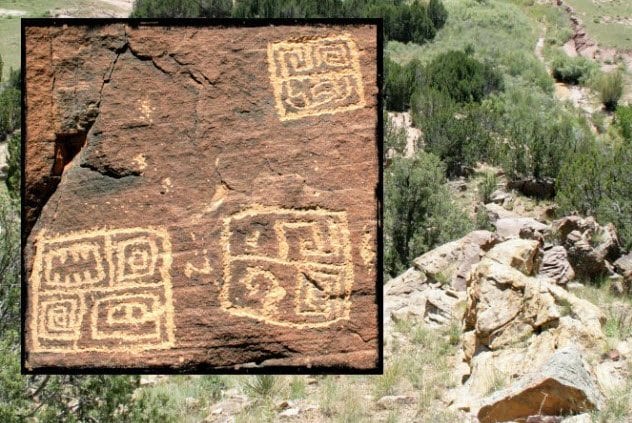
According to John Ruskamp, another group made it to the Americas thousands of years before the Vikings: the Chinese.
Ruskamp found strange symbols etched into old stones in 82 places around the southern United States. Every etching follows the same style, and none of them match anything made by the local cultures. Ruskamp, however, is convinced that they’re not just random squiggles. He believes that they are messages written in Chinese oracle bone script.
Oracle bone is one of the oldest forms of Chinese writing, which nearly faded out of use entirely around 1046 BC. If Ruskamp’s theory is right, this would mean that these Chinese settlers reached North America about 3,000 years ago.
The etchings match up to oracle bone eerily well. One in Arizona appears to read: “Set apart (for) 10 years together; declaring (to) return, (the) journey completed, (to the) house of the Sun; (the) journey completed together.” It seems to be a message left behind by explorers in a new world.
8 Ancient Ape Bones In Ireland

At the Hill of Tara in Ireland, a body has been carefully laid to rest. Its bones were given a full royal treatment, but they don’t look like the bones of a normal king. Instead, the bones look an awful lot like those of an ape.
It’s not even the only set of ape bones found in Ireland. Another ape skull has been found in County Armagh that appears to have been there for about 2,300 years. Nobody knows how these apes got there. Someone in the ancient world, for some reason, was taking apes up to Ireland and burying them there.
The apes might have been traded along early routes, but there’s a fringe theory that takes it in a very different direction. An ancient Irish legend claims that a group of strangers with magical powers came to Ireland on a massive ship and ruled the people from the Hill of Tara. Some think that legend was based on a real event and that the people they thought were magic were really a group of Egyptians with advanced technology.
That’s a big leap to make just because of some ape bones—but there’s more evidence than just that. DNA testing on ancient Irish bodies suggests that they have an ancestor from the Middle East. And, not too far from the Hill of Tara, the 3,800-year-old remains of a boy have been found, wearing what appears to be an Egyptian necklace.
7 Native American Legends Of White Giants
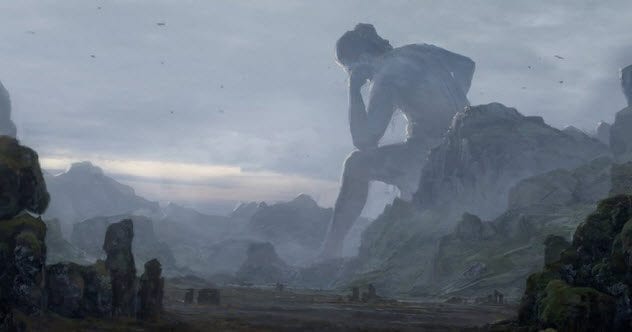
In 1857, a Native American of the Comanche tribe stood in front of a crowd and told them a story. “Innumerable moons ago, a race of white men, [305 centimeters (10′) high], and far more rich and powerful than any white people now living here, inhabited a large range of country,” he said. “They drove the Indians from their homes, putting them to the sword, and occupying the valleys in which their fathers had dwelt.”
It seemed like a parable of what was happening now. But all that changed when what appeared to be a Greek medallion and two coins was found in Oklahoma. After that, genealogist Donald Yates started piecing together the evidence and realized that this wasn’t an isolated story.
The Choctaws also had a story about “a race of giants” with white skin who lived in what is now the state of Tennessee—and other tribes had some stories that were oddly similar. The Greek writer Strabo wrote about a “Western Continent,” suggesting that he might have had some knowledge of the Americas.
Yates believes that these native stories might not be entirely made up. Greek explorers may have actually made it to the Americas and fought with the people there, leaving behind a legacy that grew bigger every time the story was told.
6 Mayan Murals Showing White-Skinned Warriors
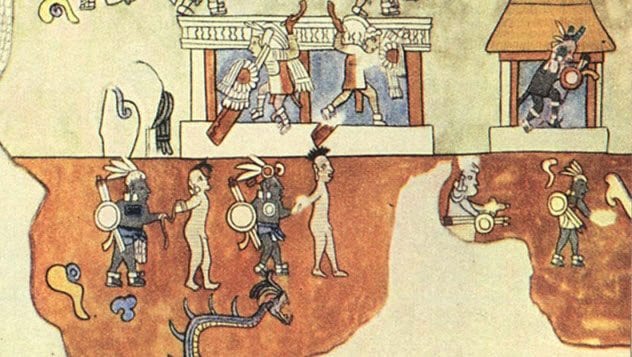
Inside the Temple of the Warriors in Chichen Itza, there are murals depicting a scene that doesn’t seem to fit the Maya’s surroundings. The murals show brutal battles fought between a very diverse group of people for pre-Columbian Mexico. Some have pale white skin, some are pitch-black, and others are brown.
On its own, that could just be an artistic choice. But other evidence supports the theory that different races of people might have fought around modern Mexico. For one, when Hernan Cortes reached Mexico, he claimed that the people there hailed him as a returning “white lord”—suggesting that another white person had been there before.
And the Maya left behind a story called the “Dance of the Giants.” In it, a white giant pairs up with the Maya and helps them fight off a black giant who’s harassing them. According to one controversial theory, all this really happened. The black-skinned giants, it’s believed, were Aztecs moving in from the North. And the white-skinned giants might be Vikings.
As early as 1789, there was speculation about Viking explorers reaching modern Mexico. One in particular, Ari Marson, was sent off course by a storm while trying to make it to Greenland. According to the theory, Marson may have ended up in Mayan territory a little after the Aztecs and he might have left his mark on their history.
5 A Temple To An Egyptian Goddess In India
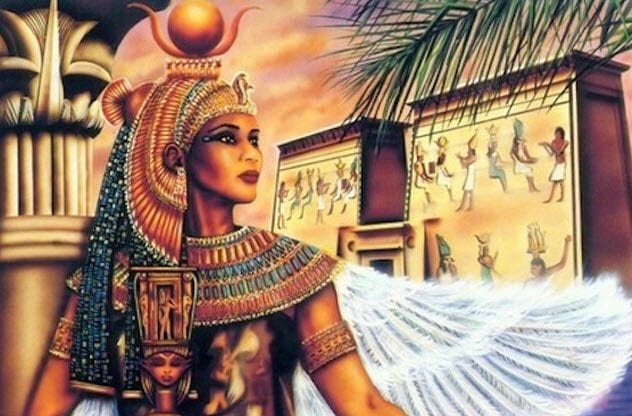
On the western coast of India, there are the ruins of a temple to the goddess Pattini. It’s not a particularly strange thing to find in India—except that there’s a secret chamber underneath that’s rumored to hold an underground shrine to the Egyptian goddess Isis.
The ruins are now owned by a Hindu temple, so nobody’s been able to actually check what’s underneath them. But according to writer Chris Morgan, the idea that it was a secret shrine to an Egyptian goddess fits. He believes that an Egyptian traveler may have come to India and started a cult dedicated to his own goddess.
Morgan believes that the idea of the goddess Pattini came from this cult. He points out some major similarities in the two legends, both of which are about women defined by the brutal murder and dismemberment of their husbands. He thinks that Pattini might be an Indian evolution of the concept of Isis spread through that shrine—a little in the way that Egyptian culture influenced Hinduism.
4 The Giant Village Of Peru
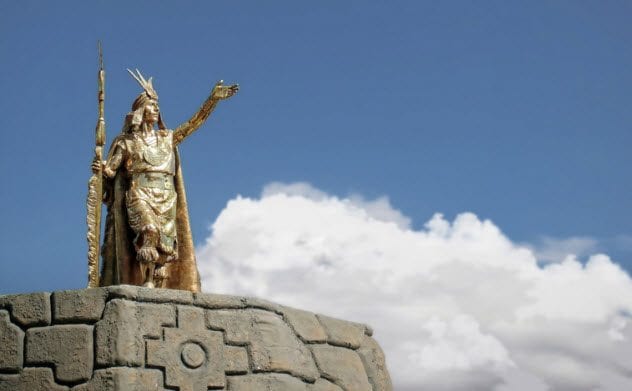
When the Spanish first came to Peru, conquistador Pedro Cieza de Leon recorded everything he could in a book called The Chronicles of Peru. It’s full of incredibly detailed and accurate descriptions of the cultures of the natives, the conquests by the Spanish, the details of the environment—and strangely, a village built by giants.
Cieza de Leon recorded a native legend about giants who arrived “in boats made of reeds, as big as large ships.” He said, “From the knee downward, their height was as great as the entire height of an ordinary man.” According to the legend, the giants built wells that were beyond the native technology as well as massive villages to accommodate their size. Later, a great fire came down and consumed the giants.
Oddly, though, Cieza de Leon claimed to have seen the village and the well built by the giants. He said that they were big enough to fit the story. He even claimed to have seen a giant’s skull and a femur and attested that other Spaniards saw teeth that must have weighed 0.2 kilograms (0.5 lb).
We don’t have these artifacts anymore, so we can’t confirm it. But it’s hard to understand why Cieza de Leon would make up lies to support a native legend.
It’s not clear what he saw. Was he deceived? Did he make it up? Or did the Spanish conquistadors really find something in Peru that suggested they weren’t the first foreign visitors to arrive?
3 The Marcahuasi Ruins
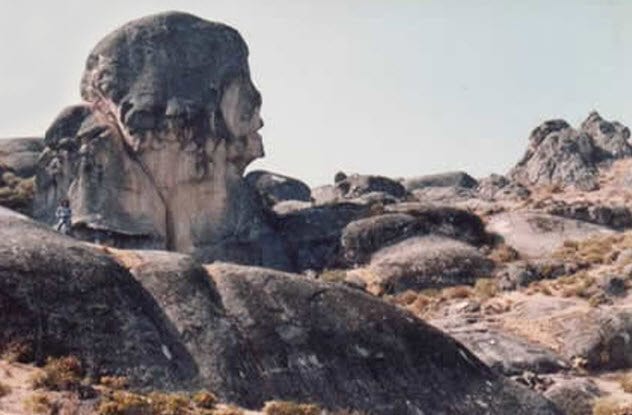
In the Andes Mountains, there are strange rocks known as the Marcahuasi Ruins. They appear to be rocks carved by human beings, sculpted to be shaped like human heads. One, in particular, looks almost exactly like a crude copy of the Egyptian Sphinx.
It’s possible that these rocks took their shape by pure, random erosion. But there are some people who don’t think it’s possible. The theory that the rocks were deliberately sculpted by an unknown people is out there—although it’s mostly supported by some pretty off-the-wall theories, including stories about aliens and mystical healing powers.
One of the more popular theories comes from an archaeologist who claims that the site was built by a biblical civilization called the Masma, who traveled to Peru and carved crude imitations of the wonders they’d seen in Egypt. His theory, though, comes from having seen it in a dream, which is a slightly less-than-scientific approach to history.
Still, even if they weren’t built by aliens or by biblical tribes, it’s not out of the question that someone carved these rocks—making them an incredible work of art still without a name for its creator.
2 The Three Handbags Of Heaven
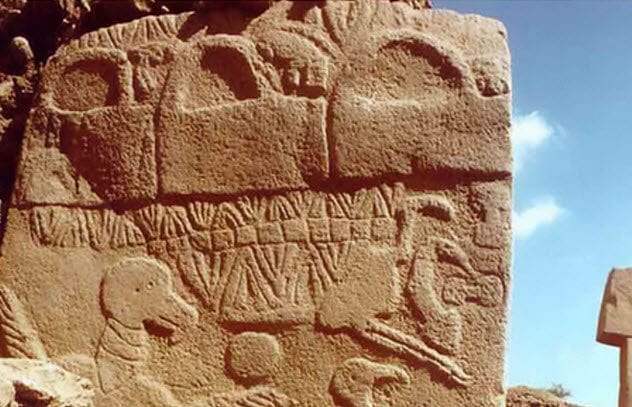
There’s a strange design that keeps popping up all around the world. It shows something that looks like a little handbag, usually drawn in groups of three and usually up in the sky. And nobody really knows what they mean.
The oldest one in Turkey shows three handbags floating over all of creation. It’s far from the only one, though. The same handbags have been seen in art from all around the world, including India, Egypt, and even Central America. It seems to be something that’s been passed on from an ancient Middle Eastern culture—which might make it a way to trace where groups of people came from.
That’s why it’s interesting that the Maori of New Zealand used the three handbags, too. They have a myth about a hero named Tane who went up to Heaven to get three baskets of knowledge—an image that seems strangely similar to the one carved in a rock in Turkey.
It could just be a coincidence. But this might be a strong sign that the Maori have ancestors who once lived in the Middle East, long before they moved to New Zealand.
1 The Redheaded Giants Of Lovelock Cave
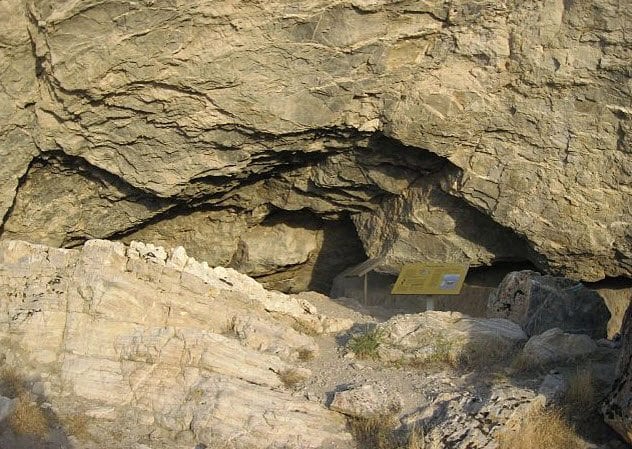
In 1911, miners working in Nevada’s Lovelock Cave were digging through piles of guano when they stumbled upon a massive wealth of ancient Indian relics. The miners started searching through the relics and found something even more incredible—the mummified remains of a 198-centimeter (6’6″) man with red hair.
The cave soon turned into an archaeological dig site, and some incredibly strange things were found. Inside, there were 38-centimeter (15 in) sandals, which appeared to have been used by a very large person, and a giant handprint that was twice the size of that of a normal man.
Some believed that this backed up the Paiute legend about redheaded, “freckle-faced” cannibals called the Si-Te-Cahs coming onto their land. The giants, they said, came by boats and preyed on them until the Paiute managed to chase the giants into a cave and set it on fire.
The original redheaded mummy has been destroyed, making the story impossible to prove, and some alternative explanations have been created. Several people, though, insist that they saw it firsthand. If they’re telling the truth, it might just mean that the Si-Te-Cahs were a real group of violent European explorers—people who tormented the Native Americans and met their end in Nevada.








